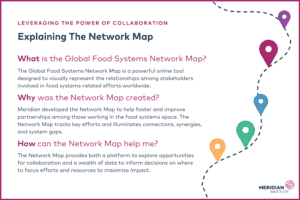Unveiling the Global Food Systems Network Map: Encouraging Connections and Collaboration
11 October 2023We are delighted to share the public launch of the Global Food Systems Network Map. This effort is a prime example of what Meridian’s mission is all about: building understanding, guiding collaboration, and driving action around challenging environmental issues.
We believe that a tool like this Network Map is an important contribution in the global food systems space. It creates a foundation from which stakeholders can better execute their work by tracking efforts across the space; highlighting existing connections between institutions, multi-stakeholder initiatives, and funders, and by signaling where focus may be concentrated; or where system gaps are present.
Built for a More Efficient System

We built this Network Map to serve as a platform for anyone working in the global food systems space to explore opportunities for collaboration and further the impact they’re making. Organizations can use the map to identify others working in a specific area of interest and see what other entities those organizations are connected to. From there, stakeholders will be able to minimize duplicities, explore gaps, and chart new partnerships.
Dataset Takeaways
There are some exciting takeaways we’ve already gleaned from using the Network Map. And, because this dataset is ever-evolving, there will continue to be powerful insights and trends learned from the Network Map. In our analysis thus far, we found that the global food-systems network is a fairly distributed, active, and dynamic space. This is because there is no one “power hoarder”, or institution that is unwilling to share their work publicly and collaborate across the food-systems landscape. According to our findings, the network of multi-stakeholder initiatives in the global food systems operates as a healthy and highly distributive network.
That being said, we have identified a number of places for exploration. Specifically, we have found five areas where efforts that take the form of multi-stakeholder collaborations in the map are less likely, therefore providing the most opportunity for collaboration and potential improvement:
- Alternative Protein Consumption
- Forestry
- Forest Carbon
- Water Resource Management
- Forced Labor
We also believe that the Network Map is a fantastic resource to explore areas of connection because it includes both terrestrial and aquatic initiatives. This presents a unique opportunity to see areas of overlap. For example, we note that both aquatic and terrestrial initiatives are actively focusing on topics such as adaptation and migration, food and nutrition security, and working with small-scale and smallholder producers. This presents opportunities for alignment and enhanced impact. Both types of initiatives are also spread well across a range of systems drivers, suggesting opportunity for cross-learning in approaches.
Continually Learning and Evolving
Given the constant change within the global food systems landscape, we recognize the perpetual need to update and improve the Network Map. The iteration released in October 2023 is based on preliminary data gathering and should not be viewed as a complete and final view of every multi-stakeholder initiative actively working in food systems. It is important to note the Network Map tracks connections among and between multi-stakeholder initiatives based on activities they carry out and outcomes they focus on. This limits options for relationship-based social network analysis but opens up systemic insights on gap discovery, possible collaborations outside known social circles, and more. Meridian looks to update the Global Food Systems Network Map quarterly and identify key insights to support actions in the food system. These insights can be found here and will be updated as we collect additional data and information.
We recognize that with its release some of the data in the Network Map may be incomplete. As such, we are actively identifying and incorporating new information to improve the Map and enhance its usefulness to those working in food systems.
That’s where you come in. We welcome your thoughts or knowledge about this space as we rely on your input to make the Map even better with each update. Do you know of any multi-stakeholder initiatives that aren’t included but should be? Is there funding data we’re missing? Please feel free to contact us! You can send your comments, revisions, and recommendations via our contact form.
The Global Food Systems Network Map is a first step in improving the constantly changing landscape of terrestrial and aquatic food systems. This tool allows you to zoom into specific areas within the food system, and zoom out to identify connections, trends, and opportunities. Through visualizing the connections between partners and projects, we hope it serves those working for food system transformation well by identifying opportunities for collaboration and gathering insights on how to focus efforts and resources for maximum collective impact.